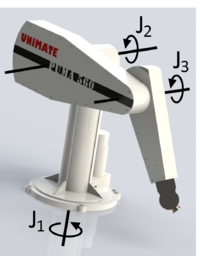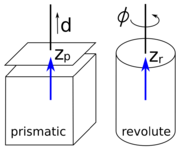Types of joints
| ← Back: Notation of links, joints and coordinate frames | Overview: Denavit-Hartenberg Convention | Next: Common normal → |
There are two types of joints used for robotic arms, each with one single degree of freedom. In the following the abstractions shown in the figure on the left will be used. The first type is the prismatic joint, that allows for translational movement along the joint axis. The displacement is described by the joint variable, for example  like in the figure. The direction of the positive displacement is always indicated with a small arrow. The second joint type is the revolute joint. A revolute joint allows for a rotation about the joint or rotation axis, respectively, and its joint parameter is the rotation angle, named
like in the figure. The direction of the positive displacement is always indicated with a small arrow. The second joint type is the revolute joint. A revolute joint allows for a rotation about the joint or rotation axis, respectively, and its joint parameter is the rotation angle, named  in the figure. The curved arrow around the rotation axis indicates the rotation direction for positive angles.
The Puma560 for example has three revolute joints, marked as
in the figure. The curved arrow around the rotation axis indicates the rotation direction for positive angles.
The Puma560 for example has three revolute joints, marked as  ,
,  and
and  in the figure on the right.
in the figure on the right.
For the assignment of coordinate frames, the main joint axes are important. Like can be seen as blue arrows in the above figure on the left, the main axis  of a prismatic joint is the axis along which the displacement in positive direction is applied. For a revolute joint, the main axis
of a prismatic joint is the axis along which the displacement in positive direction is applied. For a revolute joint, the main axis  is the rotation axis. The direction of the rotation axis and so of the main axis is depending on the positive rotation direction. When you hold your right hand like shown on the right and point your thumb in the direction of the rotation axis, the four other fingers indicate the rotation direction for positive angles. So the right hand can be used to determine the direction of the main axis. In the figure on the left, the thumb of the right hand has to point upwards, so that the four fingers correspond to the direction of the arrow indicating the positive rotation direction. Thus the main axis is directed upwards as well.
is the rotation axis. The direction of the rotation axis and so of the main axis is depending on the positive rotation direction. When you hold your right hand like shown on the right and point your thumb in the direction of the rotation axis, the four other fingers indicate the rotation direction for positive angles. So the right hand can be used to determine the direction of the main axis. In the figure on the left, the thumb of the right hand has to point upwards, so that the four fingers correspond to the direction of the arrow indicating the positive rotation direction. Thus the main axis is directed upwards as well.
The left side of the figure below shows a manipulator consisting of 4 revolute joints and one prismatic joint. Regarding the arrows indicating the rotation direction and using the right hand rule, the main joint axes can easily be determined for the revolute joints. For the prismatic joint it is quite easier, as the arrow is already showing the positive direction of the translation. The resulting main joint axes are shown as dashed blue arrows on the right side of the figure. |



